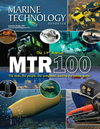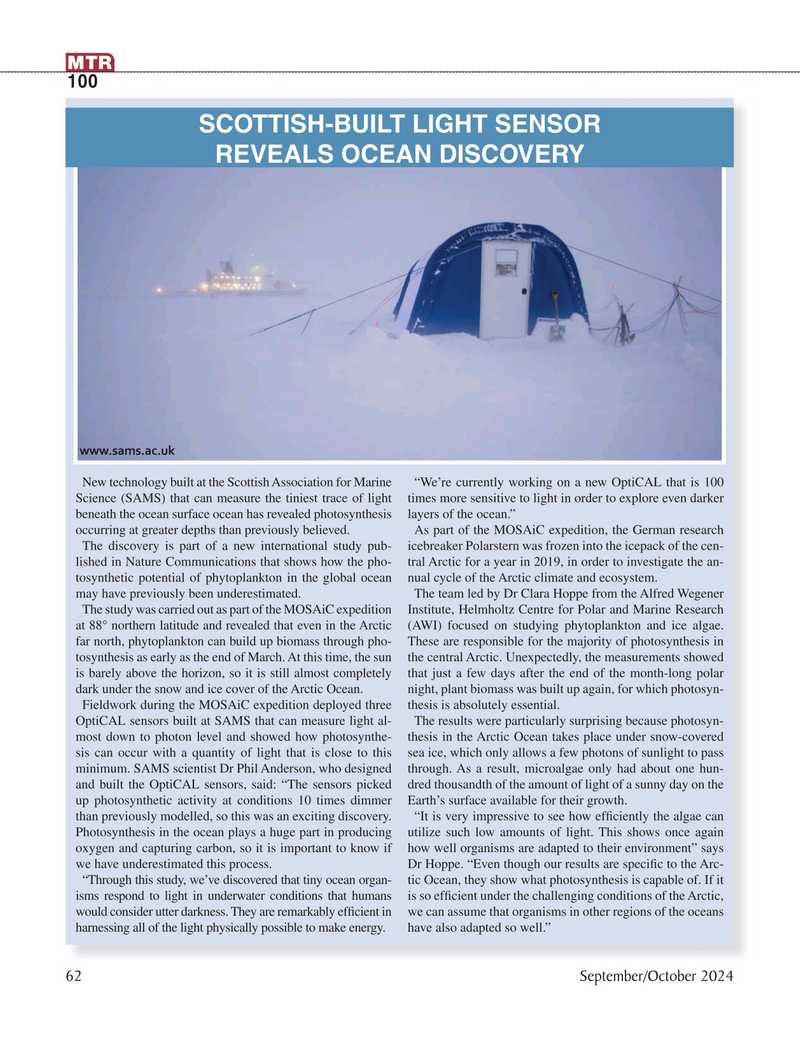
Page 62: of Marine Technology Magazine (September 2024)
Read this page in Pdf, Flash or Html5 edition of September 2024 Marine Technology Magazine
MTR 100
SCOTTISH-BUILT LIGHT SENSOR
REVEALS OCEAN DISCOVERY www.sams.ac.uk
New technology built at the Scottish Association for Marine “We’re currently working on a new OptiCAL that is 100
Science (SAMS) that can measure the tiniest trace of light times more sensitive to light in order to explore even darker beneath the ocean surface ocean has revealed photosynthesis layers of the ocean.” occurring at greater depths than previously believed. As part of the MOSAiC expedition, the German research
The discovery is part of a new international study pub- icebreaker Polarstern was frozen into the icepack of the cen- lished in Nature Communications that shows how the pho- tral Arctic for a year in 2019, in order to investigate the an- tosynthetic potential of phytoplankton in the global ocean nual cycle of the Arctic climate and ecosystem. may have previously been underestimated. The team led by Dr Clara Hoppe from the Alfred Wegener
The study was carried out as part of the MOSAiC expedition Institute, Helmholtz Centre for Polar and Marine Research at 88° northern latitude and revealed that even in the Arctic (AWI) focused on studying phytoplankton and ice algae. far north, phytoplankton can build up biomass through pho- These are responsible for the majority of photosynthesis in tosynthesis as early as the end of March. At this time, the sun the central Arctic. Unexpectedly, the measurements showed is barely above the horizon, so it is still almost completely that just a few days after the end of the month-long polar dark under the snow and ice cover of the Arctic Ocean. night, plant biomass was built up again, for which photosyn-
Fieldwork during the MOSAiC expedition deployed three thesis is absolutely essential.
OptiCAL sensors built at SAMS that can measure light al- The results were particularly surprising because photosyn- most down to photon level and showed how photosynthe- thesis in the Arctic Ocean takes place under snow-covered sis can occur with a quantity of light that is close to this sea ice, which only allows a few photons of sunlight to pass minimum. SAMS scientist Dr Phil Anderson, who designed through. As a result, microalgae only had about one hun- and built the OptiCAL sensors, said: “The sensors picked dred thousandth of the amount of light of a sunny day on the up photosynthetic activity at conditions 10 times dimmer Earth’s surface available for their growth. than previously modelled, so this was an exciting discovery. “It is very impressive to see how ef? ciently the algae can
Photosynthesis in the ocean plays a huge part in producing utilize such low amounts of light. This shows once again oxygen and capturing carbon, so it is important to know if how well organisms are adapted to their environment” says we have underestimated this process. Dr Hoppe. “Even though our results are speci? c to the Arc- “Through this study, we’ve discovered that tiny ocean organ- tic Ocean, they show what photosynthesis is capable of. If it isms respond to light in underwater conditions that humans is so ef? cient under the challenging conditions of the Arctic, would consider utter darkness. They are remarkably ef? cient in we can assume that organisms in other regions of the oceans harnessing all of the light physically possible to make energy. have also adapted so well.” 62 September/October 2024
MTR #7 (50-65).indd 62 10/3/2024 12:03:42 PM

 61
61

 63
63
